
Many of us will know blokes who scowl and mutter across the campfire about Toyota’s decision to discontinue the 80 Series Land-Cruiser.
This article was originally published in 4x4 Australia’s November 2010 issue
Launched 20 years ago and replaced more than 10, the 80 Series was at first regarded with suspicion: the rounded new body hid a lethargic engine, and its new coil-sprung suspension had a big question mark over it compared to the previous tried ’n’ true leaf springs.
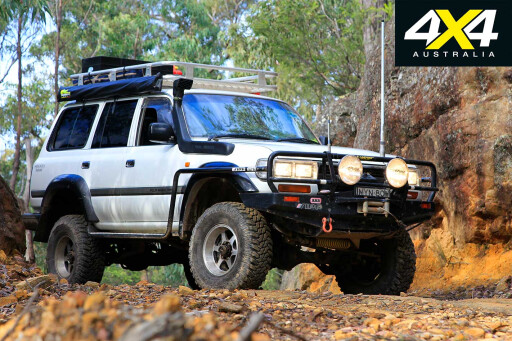 But later, fitted with a gruntier, 4.5-litre twin-cam four-valve petrol six that offered V8-like outputs of 158kW and 373Nm – or the option of two 4.2 diesels – Toyota’s 1990s LandCruiser became one of the most highly-respected vehicles in the company’s history. Which brings us to Simon Carter’s 80 Series LandCruiser.
But later, fitted with a gruntier, 4.5-litre twin-cam four-valve petrol six that offered V8-like outputs of 158kW and 373Nm – or the option of two 4.2 diesels – Toyota’s 1990s LandCruiser became one of the most highly-respected vehicles in the company’s history. Which brings us to Simon Carter’s 80 Series LandCruiser.
Eighteen months ago he grabbed an already legendary vehicle and made it even better with a bunch of sensible but serious mods aimed at making it an even more useful vehicle in the bush. And he didn’t spend a motza doing it, either.
 Simon shopped smart and tracked down a LandCruiser with a lot of extra specialist hardware installed – not bad work for a bloke who was shopping for a Nissan!
Simon shopped smart and tracked down a LandCruiser with a lot of extra specialist hardware installed – not bad work for a bloke who was shopping for a Nissan!
Since then, he’s just added a few tweaks of his own after making sure he was in the right place at the right time with the right amount of cash.
“I was looking at Nissan Patrols,” Simon says. “I was steering clear of diesels but wanted something that was on LPG so it wasn’t too expensive to run.
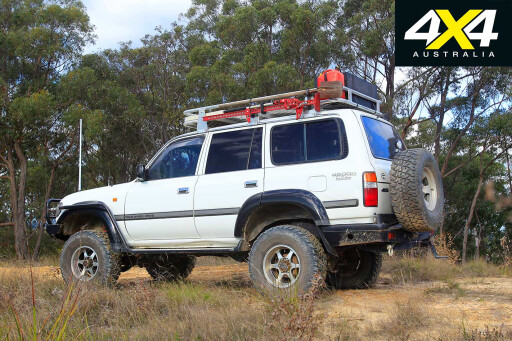 “Then I found this Toyota – it ticked all the boxes [with accessories and equipment], but wasn’t on LPG and it was an auto. I wasn’t all that keen on autos, but it had too much gear on it for me to ignore.”
“Then I found this Toyota – it ticked all the boxes [with accessories and equipment], but wasn’t on LPG and it was an auto. I wasn’t all that keen on autos, but it had too much gear on it for me to ignore.”
After all, LPG could be fitted later and an automatic trans is an asset in some off-road situations, as well as being easier to live with around town. The Cruiser was being sold with a brand new Engel fridge and a second set of wheels and tyres thrown in, too, which sweetened the deal.
From nose to tail, this tourer wants for little, with an enviable list of mechanical and camping/touring modifications. The body has been lifted 50mm over its chassis and the suspension is taller, too, thanks to taller coils, Tough Dog dampers and some Snake Racing extra-length swaybar hardware.
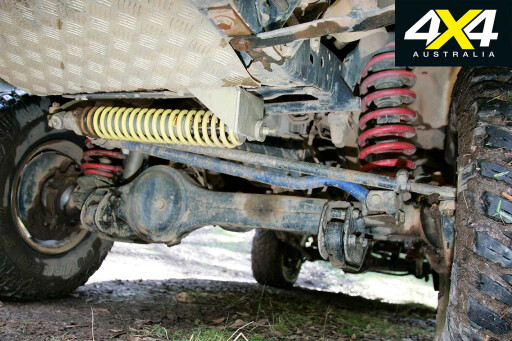 The Cruiser came equipped with a dual battery system, but the second battery was initially installed in the cabin so Simon relocated it to the engine bay with Piranha hardware. There, it not only frees up interior space for carrying gear and for sleeping, but can better assist the first battery in powering the Warn winch that lives in the modified ARB bar.
The Cruiser came equipped with a dual battery system, but the second battery was initially installed in the cabin so Simon relocated it to the engine bay with Piranha hardware. There, it not only frees up interior space for carrying gear and for sleeping, but can better assist the first battery in powering the Warn winch that lives in the modified ARB bar.
A Safari snorkel keeps water out during creek crossings, as do extended breathers for both ARB Air Locker-equipped axles. The front axle has also been converted to free-wheeling hubs using Mark’s Adaptors hardware.
 “I think there might be a crawler gear in the transfer case, too,” reckons Simon. “It really is good in first gear, even with the auto and larger tyres.”
“I think there might be a crawler gear in the transfer case, too,” reckons Simon. “It really is good in first gear, even with the auto and larger tyres.”
The Air Lockers’ compressor (installed under a front seat) was a bit dodgy when Simon bought the Cruiser so was replaced with a new ARB one that – of course – makes air available for tyre inflation. The Cooper STTs are brand new; Simon was happy with his previous Coopers but downsized from 305 to 285 to eliminate the larger tyres’ occasional scrubbing against the mudguards.
TJM is the sticker on the rear bar/tyre carrier, with a Hayman Reece towbar under it. Simon doesn’t often tow, but the relocated spare wheel is necessary to allow space for an LPG tank.
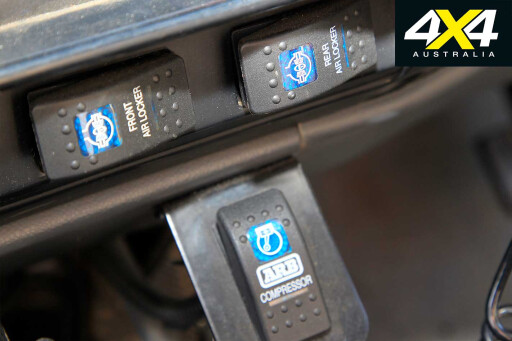 A little known outfit, roofcage.com, provided the roof cage for when Simon needs to carry extra equipment or fuel. Simon also added the Ironman awning, the Kaymar jack and shovel holder and upgraded the stereo to one that is iPod compatible.
A little known outfit, roofcage.com, provided the roof cage for when Simon needs to carry extra equipment or fuel. Simon also added the Ironman awning, the Kaymar jack and shovel holder and upgraded the stereo to one that is iPod compatible.
There’s Uniden and GME communications gear, and the standard Toyota seats, although not too bad in an 80 Series, feel like milk crates compared to the two Aussie-made butt-hugging Stratos 3000 buckets that now take pride of place up front. MSA canvas covers, featuring integral map pockets, protect them.
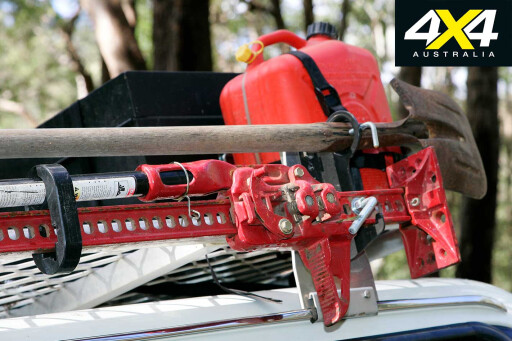 Out back, Simon’s additions include a few more 12V outlets for powering accessories and a 1000W Jaycar inverter so he and daughter Madison – also a keen outdoors person – can charge and run computers, cameras and other 240V gear without too much hassle.
Out back, Simon’s additions include a few more 12V outlets for powering accessories and a 1000W Jaycar inverter so he and daughter Madison – also a keen outdoors person – can charge and run computers, cameras and other 240V gear without too much hassle.
For many of the boys’ weekends, Simon sleeps in the Cruiser so wanted the top of his drawer system to be flat (Toyota’s factory-fit rear-most pews have been removed). When Madison comes along for the weekend, she gets the cabin and Simon rolls out his swag.
 For that extra touch of luxury after a long, dusty day of driving in the bush, Simon has installed a Twine shower system under the bonnet. It’s obvious this vehicle has most of the ingredients to be a terrific tourer. Except one: the high-height body.
For that extra touch of luxury after a long, dusty day of driving in the bush, Simon has installed a Twine shower system under the bonnet. It’s obvious this vehicle has most of the ingredients to be a terrific tourer. Except one: the high-height body.
“When I got it, it had no swaybars and wobbled all over the place,” recalls Simon. “I went to a wrecker and put those back on because I reckon it was unsafe.”
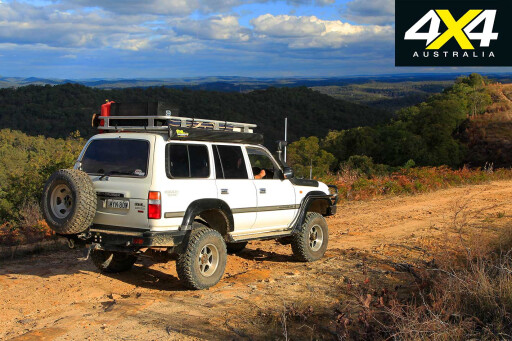 Simon has installed a Tough Dog steering damper and wants to upgrade the Cruiser’s four other Doggies, too: “I want to install the nine-way adjustable ones. Because it’s so tall, I want to tighten it up on-road and have the option to keep it soft when it needs to be.”
Simon has installed a Tough Dog steering damper and wants to upgrade the Cruiser’s four other Doggies, too: “I want to install the nine-way adjustable ones. Because it’s so tall, I want to tighten it up on-road and have the option to keep it soft when it needs to be.”
Having another daily-driver means the Cruiser is garaged most of the time, ready for weekend camping trips without the compromises of marshmallow manners, excessive tyre wear or thirsty fuel consumption around suburbia. But despite Simon’s best intentions, circumstances have kept him within the confines of Sydney suburbia for the time being.
“Mick [a mate] and I were supposed to be gone by now,” Simon says of his intended across-Oz trip. “But I have to finish my house first!”
Going on Gas
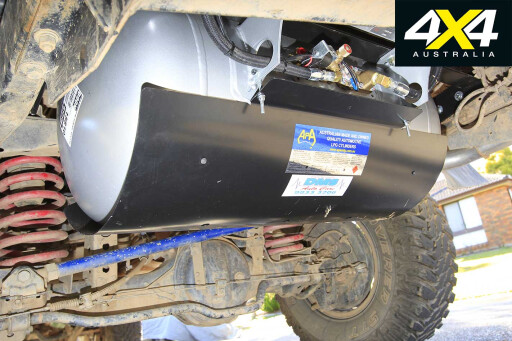 Simon has recently joined the ranks of those making the day-to-day running costs of the (let’s be man enough to admit it) heavy and cumbersome 80 a little easier on the hip pocket.
Simon has recently joined the ranks of those making the day-to-day running costs of the (let’s be man enough to admit it) heavy and cumbersome 80 a little easier on the hip pocket.
The system Simon chose is a Parnell VSI dual-fuel, electronically controlled, multi-point sequential vapour injection system. Mimicking a vehicle’s standard EFI system, VSI (vapour sequential injection) systems cost more than old-tech LPG installations that simply dump the gas into the intake at one point, but by all accounts the result is worth it.
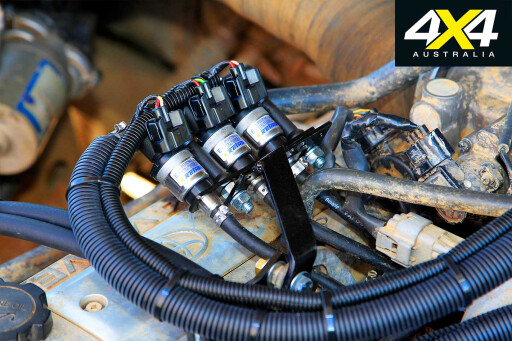 Gas injection systems provide better mixture control, fuel economy (usually around 10 percent), driveability and reliability – especially a reduction in damaging intake manifold backfires that can be expensive to deal with.
Gas injection systems provide better mixture control, fuel economy (usually around 10 percent), driveability and reliability – especially a reduction in damaging intake manifold backfires that can be expensive to deal with.
At the time of his installation, Simon pocketed the $1750 Australian government grant toward the $4200 cost of the conversion. The grant is gradually being reduced towards its termination in 2013 but will remain at $1500 until the end of June 2011.
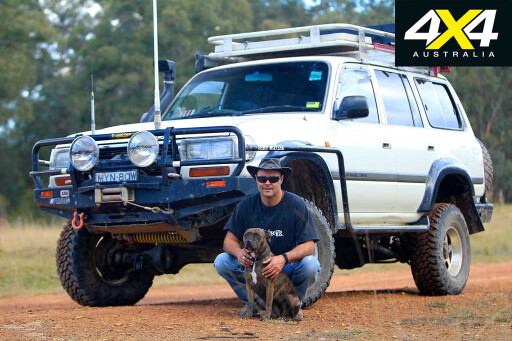 1994 Toyota LandCruiser 80 Series
1994 Toyota LandCruiser 80 Series
Owner: Simon Carter
Engine: 1FZ-FE 4500i in-line six cylinder DOHC
Power: 158kW at 4600rpm (standard)
Torque: 373Nm at 3200rpm (standard)
Transmission: Four-speed automatic
List of modifications
Engine: Sequential multi-point LPG gaseous injection system
Suspension (front): Pedders coil spring (100mm longer than standard) with Tough Dog dampers; relocated upper shock mounts; Snake Racing extended swaybar links; caster bushes in lower control arms; Tough Dog RTC steering damper; Snake Racing track bar
Suspension (rear): Pedders coil spring (100mm longer than standard) with Tough Dog dampers; relocated upper shock mounts; Snake Racing extended swaybar links and adjustable Panhard bar
Wheels & Tyres: Enkei wheels with Cooper STT 285/75-16
Exterior modifications: ARB front and rear Air Lockers; part time 4WD/freewheeling front hub conversion; 50mm body lift; modified ARB bullbar; Warn winch; Lightforce Blitz driving lights; ARB sidebars; Safari snorkel; roof cage with Ironman awning; TJM rear bar with spare wheel mount; Hayman Reece towbar; Kaymar jack/shovel holder; LED rear work/camp light; dual battery system with Piranha isolator; Twine shower system; diff breathers
Interior modifications: MOMO steering wheel; Stratos 3000 front seats; MSA canvas seat covers; Milford cargo barrier; Engel and Bushman fridges; 4 x 12V accessory sockets; Jaycar 1000W inverter; GME and Uniden UHF radios; Alpine iPod-compatible head unit and amplifier; 4 Focus speakers and 12-inch sub; ARB on-board air compressor; home-made drawer/storage system. For camping: Garmin GPS; Bushman exhaust jack; Honda generator; hi-lift jack

COMMENTS